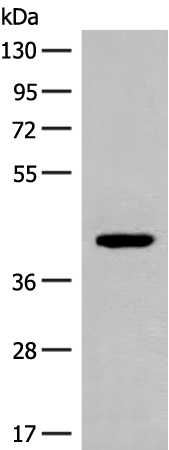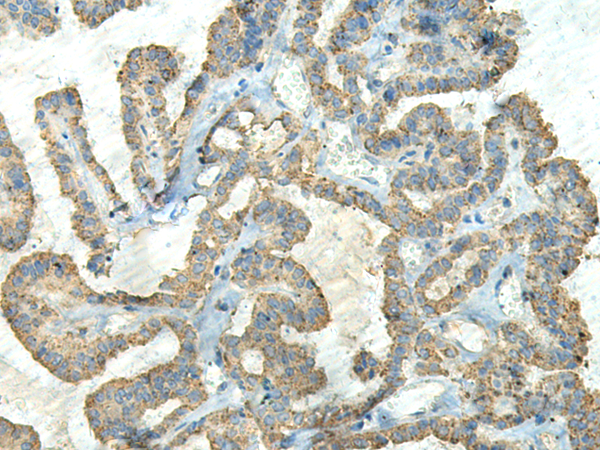


| WB | 1/500-1/2000 | Human,Mouse,Rat |
| IF | 咨询技术 | Human,Mouse,Rat |
| IHC | 1/50-1/300 | Human,Mouse,Rat |
| ICC | 技术咨询 | Human,Mouse,Rat |
| FCM | 咨询技术 | Human,Mouse,Rat |
| Elisa | 1/5000-1/10000 | Human,Mouse,Rat |
| Aliases | FCRN; alpha-chain |
| WB Predicted band size | 40 kDa |
| Host/Isotype | Rabbit IgG |
| Antibody Type | Primary antibody |
| Storage | Store at 4°C short term. Aliquot and store at -20°C long term. Avoid freeze/thaw cycles. |
| Species Reactivity | Human |
| Immunogen | Synthetic peptide of human FCGRT |
| Formulation | Purified antibody in PBS with 0.05% sodium azide and 50% glycerol. |
+ +
以下是关于 **FCGRT(FcRn)抗体**的3-4篇参考文献及其简要摘要:
---
1. **文献名称**:*FcRn: The Neonatal Fc Receptor Comes of Age*
**作者**:Roopenian, D.C., Akilesh, S.
**摘要**:
该综述系统阐述了FcRn(由FCGRT基因编码)在调控IgG抗体和白蛋白代谢中的核心作用,包括其介导的抗体循环机制,以及作为治疗靶点在自身免疫病和药物递送中的潜力。
2. **文献名称**:*Randomized Phase 2 Study of FcRn Antagonist Efgartigimod in Generalized Myasthenia Gravis*
**作者**:Howard, J.F., et al.
**摘要**:
该临床试验证明抗FcRn单抗Efgartigimod可通过阻断FcRn-IgG相互作用,显著降低重症肌无力患者血清IgG水平,改善临床症状,验证了FcRn抗体在自身免疫病治疗中的有效性。
3. **文献名称**:*Crystal Structure of the MHC Class I-Related Receptor FcRn Bound to Fc*
**作者**:Chaudhury, C., et al.
**摘要**:
通过解析FcRn与IgG Fc片段复合物的晶体结构,揭示了二者结合的关键位点,为设计靶向FcRn的抗体或工程化治疗性抗体(延长半衰期)提供了结构基础。
4. **文献名称**:*FcRn-Targeted Nanoparticles for Drug Delivery Across Barriers*
**作者**:Pridgen, E.M., et al.
**摘要**:
研究利用FcRn介导的转运机制,开发靶向FcRn的纳米颗粒递送系统,可增强药物穿过肠屏障或血脑屏障的效率,拓展了FcRn抗体在药物递送领域的应用。
---
**说明**:
- FCGRT基因编码FcRn的α链,上述文献均聚焦FcRn功能或其靶向抗体。
- 研究方向涵盖基础机制(Roopenian)、治疗应用(Howard)、结构生物学(Chaudhury)及药物递送(Pridgen)。
The Fc gamma receptor neonatal (FcRn), encoded by the *FCGRT* gene, is a major histocompatibility complex (MHC) class I-related receptor that plays a critical role in regulating immunoglobulin G (IgG) and serum albumin homeostasis. Discovered initially for its function in transferring maternal IgG to offspring during gestation, FcRn is expressed ubiquitously in endothelial, epithelial, and immune cells. It binds to IgG and albumin in a pH-dependent manner, protecting them from lysosomal degradation by recycling them back into circulation. This mechanism extends the half-life of IgG (up to 3 weeks) and albumin (∼3 weeks), influencing both immunity and drug pharmacokinetics.
FcRn's interaction with IgG has therapeutic implications. Blocking FcRn can reduce pathogenic IgG levels in autoimmune diseases like myasthenia gravis or immune thrombocytopenia. Drugs such as efgartigimod, an FcRn inhibitor, leverage this mechanism. Conversely, engineering therapeutic antibodies to enhance FcRn binding can prolong their serum persistence, improving efficacy.
Dysregulation of FcRn is linked to hypoalbuminemia or IgG deficiency. Research also explores its role in antigen presentation, immune tolerance, and mucosal immunity. FcRn antibodies, either as investigational tools or therapeutics, remain pivotal in studying these pathways and developing targeted therapies. Their dual utility in modulating IgG dynamics highlights FcRn's significance in both basic immunology and clinical applications.
×